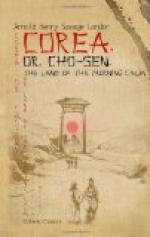Whenever I visited a monastery, I found the monks most civil and hospitable, although naturally they expect something back for their hospitality. I hardly had time to pay my chin-chins to all of them, folding my hands and shaking them in front of my forehead, bent forward, before a tray of eatables, such as beans, radishes and rice in pretty brass bowls would be produced, and a large cup of wine offered, out of which latter the whole company drank in turn. They took much interest in my sketching, and all insisted on being portrayed. Many of them possessed a good deal of artistic talent, and it is generally by their handiwork and patience that the images and statues in the temples are produced. Among them were some very intelligent faces, somewhat abruties, to use a French word, owing to the life they lead, but exceedingly bright and cheery withal, and often very witty, when one came to talk with them. As for shrewdness and quickness of perception I know no person who has these better at his command than the Corean Buddhist priest.
[Illustration: A NUNNERY]
There are also in Corea nunneries for women who desire to follow a religious life. Curiously enough, contrary to the rule with us, the Corean nuns are more emancipated than the rest of the native women. To begin with, they dress just in the same way as do the monks, shave their heads like them; and being, moreover, of a cast of countenance exceedingly ugly and not at all feminine, they might quite well, from the appearance of their faces, be taken to belong to the stronger sex. A good many of them, contrary to the case of the monks, impressed me as being afflicted with mental and bodily sufferings, and in several cases they even appeared to me to be bordering on idiocy. They always, however, received me kindly, and showed me their convents, with cells in which two or three nuns sleep together. They were not quite so careless as the monks about the duties of religion, and at the little temple close by there was a continual rattling of the gong, a buzzing, monotonous sound, enough to drive anybody out of his mind, if especially it was accompanied by the beating of drums. The temples attached to these nunneries seemed to be more elaborate inside than those of the monasteries, and when a religious ceremony has to be performed, two nuns, one in white, the other draped in a long, black-greenish gown, and both wearing a red garment thrown over the left shoulder, passed under the right arm, and tied in front with a ribbon, walk up and down inside the temple, muttering prayers, while a third female goes on rattling on the drums with all her might. Offerings of rice, beans, etc., are placed in front of the gods, a candle or two is lighted—and the nun in dark clothing holds a small gong, fastened to the end of a bent stick, and taps on it with a long-handled hammer, first gently and slowly, then quicker and quicker, in a crescendo, till she manages to produce a long




